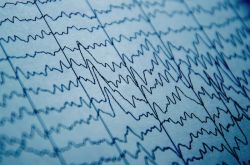Delta waves represent the brain’s deepest rhythm. They emerge during sleep, when consciousness recedes and the body enters a state of profound regeneration. At this frequency, cellular repair, immune strengthening, and neurophysiological resetting take place. This article provides an overview of why the delta rhythm is essential for brain health – and how it can be supported through non-pharmacological approaches.
What is Delta and When Does It Occur
Delta waves are the slowest type of brainwave activity, oscillating in the range of 0.5 to 4 Hz.
They appear predominantly during deep NREM sleep (slow-wave sleep, SWS), when the brain enters a state of minimal external reactivity. In this phase, the body undergoes cellular regeneration, immune restoration, and brain detoxification via the glymphatic system.
Delta oscillations originate in the frontal areas of the brain and are generated by thalamocortical loops, which inhibit cognitive activity—consciousness recedes, and the body enters a state of deep repair.
Why Delta Is So Important
The sleep phase dominated by delta waves is essential for:
-
release of growth hormone,
-
restoration of synaptic plasticity,
-
consolidation of declarative memory,
-
stabilization of the autonomic nervous system.
Lack of high-quality delta sleep—due to chronic stress, anxiety, or neurodevelopmental disorders—can lead to nervous system overload, hormonal dysregulation, weakened immunity, and emotional instability.
Delta waves are not just a marker of sleep—they are an indicator of health and inner balance.
How to Support the Delta Rhythm
Research confirms that delta activity can be supported naturally through sensory input and targeted stimulation:
-
Exposure to red and infrared light (PBM) supports melatonin production and stabilizes the circadian rhythm.
-
Calming aromatherapy (e.g., lavender, vetiver) activates the parasympathetic nervous system and facilitates deeper sleep.
-
Binaural beats in the delta range can promote EEG synchronization into slower frequencies.
-
Deep pressure stimulation (e.g., weighted blankets) enhances feelings of safety and physiological relaxation.
-
Grounding techniques (contact with nature, minerals, darkness) help to downregulate hypervigilance.
Delta in Light Brains Therapy
In Light Brains’ multisensory therapy, we create conditions that naturally support delta rhythm activation without pharmacological intervention.
We use a combination of dim light, darkness, aroma, vibration, and grounding elements that guide the nervous system toward deep rest.
We pay special attention to neurodivergent clients, who often experience fragmented or shallow sleep due to sensory overload or chronic internal alertness. Working with the delta rhythm in these cases allows a profound return to somatic presence, calm, and integration.
Sources and Further Reading
-
Achermann, P., & Borbély, A. A. (1997). Low-frequency (→ A study mapping the characteristics of deep sleep and the significance of slow (delta) waves for brain restoration.
-
Dang-Vu, T. T., et al. (2008). Spontaneous neural activity during human slow wave sleep. → Research showing how brain regions related to regeneration and memory are activated during delta sleep.
-
Mander, B. A., Winer, J. R., & Walker, M. P. (2017). Sleep and Human Aging. → Demonstrates how delta activity declines with age and how this affects cognitive function and neurodegeneration.
-
Tononi, G., & Cirelli, C. (2014). Sleep and the Price of Plasticity: From Synaptic and Cellular Homeostasis to Memory Consolidation and Integration. → A theoretical model explaining how delta sleep restores synaptic balance and supports memory consolidation.
-
Krueger, J. M., et al. (2008). Sleep function: Toward elucidating an enigma. → A review article outlining key functions of deep sleep, including immune support and neuroplasticity.
-
Diekelmann, S., & Born, J. (2010). The memory function of sleep. → Demonstrates how the delta phase of sleep is essential for storing new memories and integrating learning.
-
Hertenstein, E., et al. (2019). NREM sleep instability in patients with major depressive disorder. → Describes disrupted delta sleep structure in patients with depression and its consequences for brain and emotional function.





